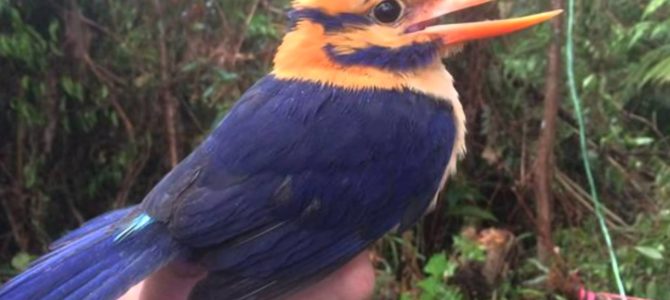
“Science” is all the rage these days, particularly among those who preen as the “party of science.” We’re not just supposed to love science. We’re supposed to love it with an intensity so great, we need to drop the F-bomb to express it. We’re supposed to learn about science from popularizers who are alternately frenetic or woozy and starry-eyed. But something must have gone wrong with all of this love of science, because it is manifesting itself in odd spasms of hostility to science.
Take the case of ornithologist Christopher Filardi, who has been hounded by online mobs and basically driven into hiding for publicly practicing science. What did he do? His crime was to euthanize a bird in order to collect it as a sample for a museum, which has been standard practice in natural science for centuries.
While the expedition was still underway, the museum released the first photographs of the bird, which seemed to be mugging for the camera. The mustached kingfisher became a viral celebrity, under headlines like ‘ridiculously gorgeous.’
It wasn’t until the public realized that Dr. Filardi had ‘collected’ the bird—killing it for the museum’s research collection—that the adulation turned to venom…. While Dr. Filardi was still on the mountain, almost entirely off the grid, the rage spread. Tens of thousands of people signed petitions that condemned his actions, and thousands more signed a petition calling for him to be fired, or even jailed….
He descended from the mountaintop into an inferno of hate. ‘If they wanted to make me feel horrible and more than a little frightened for my family or welfare,’ he told me, his voice strained, ‘it worked.’
This New York Times profile of the case does a good job of explaining why biologists take these samples. But as we all know by now, reasoning with the online mob is futile.
[Filardi] wrote an essay for Audubon explaining the many steps he’d taken to ensure that the taking of a single kingfisher would not cause harm, including a survey of the population, which he estimated at 4,000—a ‘robust number for a large island bird.’ He highlighted the role the bird played in conservation efforts: After his findings were presented to tribal, local, and national officials, they resolved to protect the area from being mined or logged. His essay received over 900 comments, the most up-voted of which called him a murderer.
This kind of reaction should remind us of previous superstitious taboos against practices like dissecting cadavers, activities that were scientifically valuable but emotionally repugnant to an ignorant mob and obscurantist authorities. In this case, the main push came from precisely the kind of left-leaning activists—particularly PETA and the animal rights crowd—who so often like to pose as advocates of science.
The comparison to a pre-scientific era only seems more appropriate the deeper you probe this case. We already see historical scholarship having to be conducted in secret, just as in the days of the monasteries, in order to avoid attack by a hostile outside world. Now the same thing is happening to science.
[I]t has led him—and many other ornithologists with whom I spoke, almost all of whom asked me not to use their names—to be extremely cautious about attracting any kind of attention. Many research expeditions are no longer being publicized; in some cases, there is a total blackout on media.
I suspect what they need most is a blackout on social media in particular. There is a lesson here about the psychology of online mobs, and a warning that in an era when science lives by social media it can die by social media.
But that is just part of a wider lesson about a broad failure of science education. Something about the efforts in recent decades to popularize science have failed to convey its essential method and outlook, opening it to the kind of sentimental emotionalism we see in the Filardi affair, where a bird is considered not as an object of scientific fascination, but as a Disneyfied anthropomorphic cartoon character.
In some ways, science has never been more popular or had more loud, self-proclaimed defenders. But it is valued and defended more as a narrative with emotional meaning—often a political narrative cited for political ends—rather than as a method of using observation, evidence, and reason to understand the world.
The attack on Filardi, and the new need to conduct science in secret, is a result of the era of IFL Science and charlatans like Bill Nye, where being “pro-science” is about reading cartoons, voting for one party’s politicians, and posting the right memes on social media—but with no need to understand science’s actual method and outlook. Science that lives by the narrative can die by the narrative.
Robert Tracinski is a senior writer for The Federalist. His work can also be found at The Tracinski Letter.









